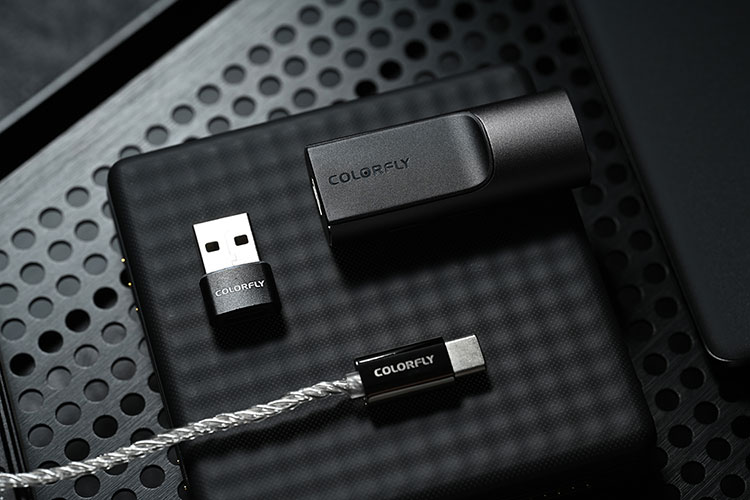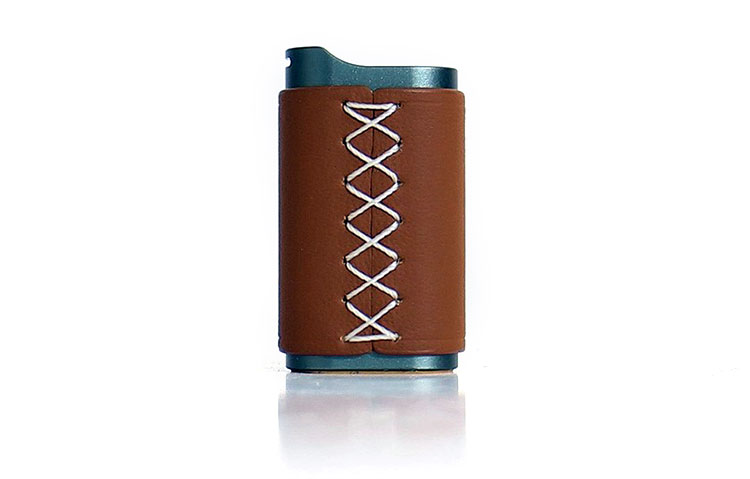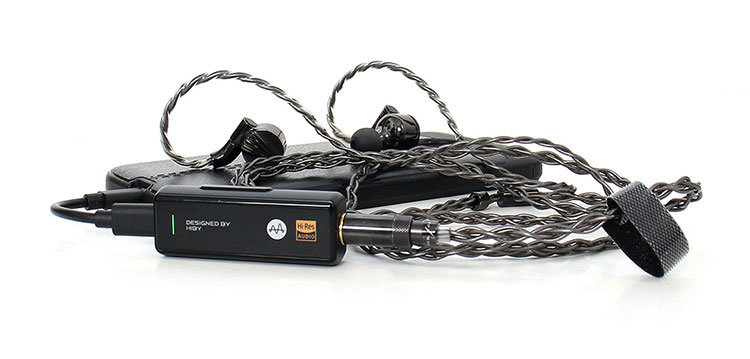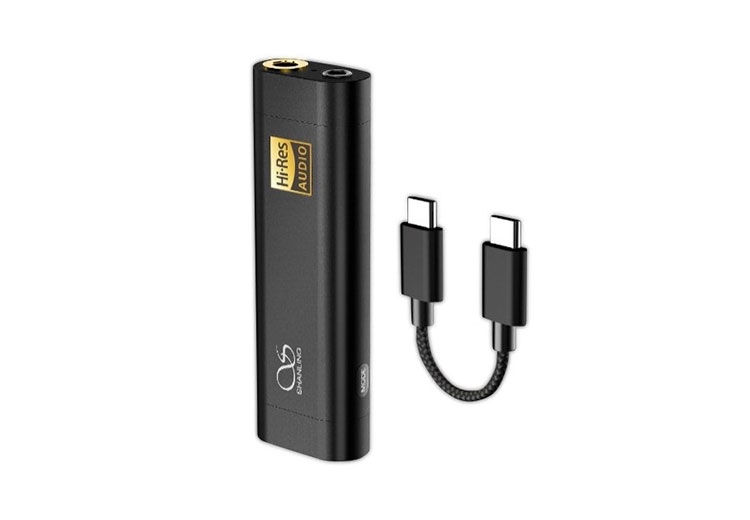Select Comparisons
ddHiFi TC44C
$119.99
Technical
Perhaps you prefer a smaller stature device and simplicity then another dongle you should consider is the ddHiFi TC44C. This dongle DAC has the same configuration far as connectivity with two outputs on board plus the same USB-C input port.
The TC44C uses dual Cirrus logic CS43131 chips that run the same PCM and native DSD with no MQA but comparatively run at up to 384k and DSD256. While the CDA M1 reaches 768k and DSD512 rates.
Although the DD HiFi TC44C has a lower output power rate of 120mW it seems rather underrated for sure since the dongle of the 4.4mm connection can push full-sized cans just fine with very little deficiency in bass response. It even does fine if you apply some boosting in the lower region which is also in line with the CDA M1.
Design
If you want a smaller dongle design the DD HiFi TC44C certainly is small considering that you still get a dual DAC chip and a dual output jack setup. The size was achieved by separating circuits and instead of using one PC board, two were used side by side.
Actually, the design has its pro points but also a con in that the all-metal body has a lanyard slot which is a good feature to have but it gets in the way of the ability to insert wide 3.5mm plugs.
For example, I was unable to use those Grado SR80X because of the non-removable wire and the width of the plug, it just would not go in. However, the TC44C has no such issue on the 4.4mm side.
One aspect I liked about the TC44C is the included stitched cover but since it’s a limited run item I cannot give assurance that you will receive one when you order it.
I think they should make another batch since the particular accessory adds value to their dongle DAC and that might gain brownie points with buyers on purchase day.
Performance
Both these dongle DACs have a somewhat aseptic or neutral character to their overall sound which is quite surprising since they use very different chipsets. The CDA M1 uses an ESS variant chip and the ddHiFi uses the Cirrus Logic alternative. Neither are known to rarely deliver the same general tone or the same type of tuning.
They both have a rather dark background and are not prone to hiss either since both units seem to have a mute feature that shuts off output while no signal is present.
The DD HiFi dongle seems to have a wider stage and a more spacious sound signature but if you prefer a more intimate presentation the CDA M1 does it better.
Both these dongles seem to have a similar amount of power drain when running off a mobile device. On average expect to see a similar 1% drain for every five minutes more or less.
The only difference here is that the CDA M1 runs warm to the touch while the TC44C seems to be the cooler running model when it comes to operating temperature.
HiBy FC5
$159.00
Technical
On a slightly higher tier sits the HiBy FC5 which is similar in design especially when it comes to connectivity but with a twist perhaps for some because the two connections come in the form of an onboard plug and a supplied cable adapter.
On the digital front, the FC5 is capable of MQA hardware rendering while the other units in this comparison are not. PCM reaches 384k but not the 768k rates of the CDA M1 and the DSD rates also drop down to 128. The lower bit rates seem to be a tradeoff for the addition of MQA hardware rendering.
Design
The shell design seems polished not in the fact that it has a high gloss finish but the assembly is quite nice. The bulk of the unit is on the high side but the shell has all rounded edges which make it a comfortable pocket carry since the body has an absence of sharp edges.
The one twist in design is that although it’s the largest dongle in this comparison it only has a single 4.4mm connection. HiBy supplies the buyer with a good quality adapter that converts the 4.4mm to a 3.5mm single-ended but it’s just that, an adapter.
If you look at it in a positive way this could actually be a good thing especially if you use a 4.4mm connection exclusively. Other dongles would then constantly have that 3.5mm plug exposed to the elements which could prove disastrous if you get caught outside on a stormy day and caught under heavy rain.
A simple solution would be to simply supply a rubber plug to cover both connections and leave the one on the connection not being used. Perhaps then manufacturers could stick an IPX rating on their units and to their benefit make their dongles more waterproof and therefore make them a more sellable item.
Performance
Somehow it seems that in this case and within this comparison the more expensive unit is the least capable of running a high impedance demanding headphone especially if it demands high current as in for example a full-sized planar.
The particular lies in the fact that the FC5 is only capable of a 2 volt or 125mW per side output which is more than enough for practically every IEM out there but might present a challenge for some power-hungry cans.
To its credit and where the benefit and strong point of the FC5 lie with the warm clean and dynamic sound signature and the darkest background of the group. It would probably be chosen in a blind test for that in particular and especially if paired with a good-sounding IEM.
Shanling UA2
$85.00
Technical
Although the Shanling UA2 has the lowest price tag in this comparison it seems to compete well since the maximum power output is a very similar 195mW compared to the 200mW that comes off the CDA M1.
The UA2 uses a single DAC chip but is capable of that amount of output due to the addition of a Ricore RE6863 chip within a dedicated headphone amplifier stage.
The UA2 runs off a single ESS ES9038Q2M chip and manages the same digital formats which are 32-bit 768 kHz PCM and DSD 512 but again, the UA2 is equally not MQA ready.
Design
To retain a slim look Shanling went with a smaller onboard 2.5mm balanced jack in combination with a 3.5mm. This might be a con to some since it seems the 4.4mm is being preferred over all other balanced connectors becoming the more common connectivity medium nowadays.
The slim body design of the Shanling UA2 is all metal with a matte finish. Both these dongles are almost the same height but the UA2 has half the girth. It still employs a removable cable design like the others in this comparison which is the preferred design in general for longevity’s sake.
Performance
I would say the UA2 is the warmest sounding dongle DAC in this comparison and warmer than most, not only in sound signature but also in operating temperature since it also develops the most heat from the pack within this comparison.
The UA2 sits somewhere around 3rd place in power output with first and second place being taken up by the FC5 and the CDA M1.
The UA2 probably has the softest sonic characteristics in general that although similar in power output to the top models here somehow has the lowest dynamics and the least impactful bottom end of the group.
As far as heat is concerned, the original firmware kept the unit active internally most times and that was apparently the source of the warmth. Shanling updated its firmware a couple of times and released versions 01.92.11 and 01.92.12 recently which promise better efficiency, compatibility, and reduced heat.
I installed both but in the end, settled for version 01.92.11 because to me it seemed more stable at higher bit rates. However, your mileage may vary and if you have a UA2 I would recommend looking into these improved firmware versions and would advise you to download them pronto.
Our Verdict
Overall, the Colorfly CDA M1 distinguishes itself by being a good choice for buyers who are looking for a simple and inexpensive dongle DAC. It has good imaging capabilities and a balanced tonality. Foremost, it delivers a good midrange quality with a better than average ability to extract detail and hidden nuances.
It does have a lack of features and there’s no app or not even an owner’s manual. I think Colorfly put all their chips on sound quality here rather than give you features that you will only use on occasions and in my opinion it worked out well for the potential buyer.
This dongle is built with a minimalistic look but focuses its talents on detail and nuances. More particularly in midrange clarity which is a welcomed change from the usual warm character of competing dongle DACs.
Colorfly CDA M1 Technical Specifications
- Colorfly α DAC.
- Supports 32-Bit/768kHz PCM signal decoding.
- Native DSD512 decoding.
- Colorfly U8 HiFi music player architecture.
- Ultra-low jitter 100M active crystal oscillator.
- RT6863 high-performance independent Op-AMP.
- JitterKill 2 independent clock architecture.
- Dual Headphone output (3.5mm+4.4mm).
- Supports both High & Low impedance modes.
- Swappable connector cables.
- Multi-platform compatibility.
- Robust & Compact.
- USB connector: Type-C.
- Bitrate support: PCM 32-bit/768kHz, DSD512 natively, DSD256 DOP.
- SNR: 120dB.
- THD+N: -100dB@600Ω, -98dB@32Ω.
- Output level: 2V RMS (3.5mm), 4Vrms (4.4m).
- Output power: 100mW (3.5mm), 200mW (4.4mm).
- Frequency response range: 20Hz-20 kHz.
- DNR: 120dB.





